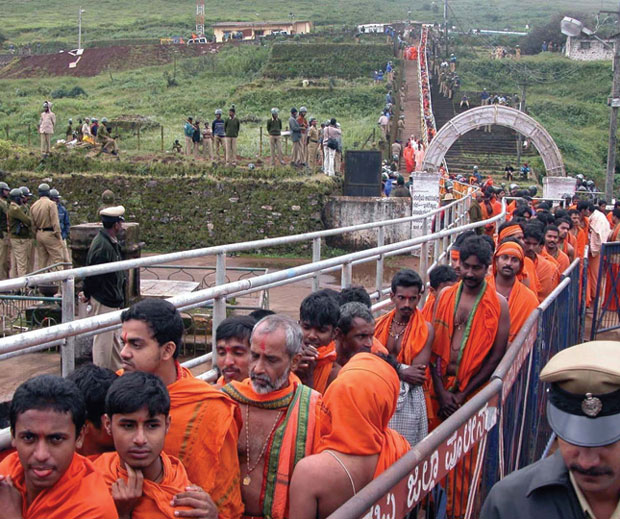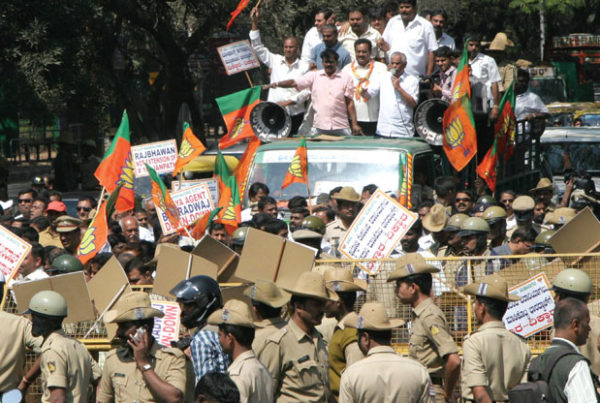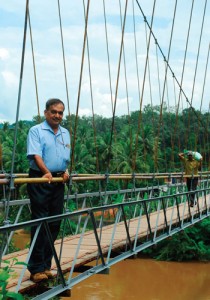Bababudangiri, Karnataka’s communal smoke pit, is simmering again as restoration work at the site smacks of a right-wing agenda. Sanjana Chappalli reports
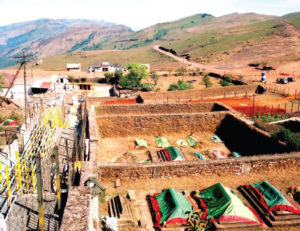 Slow fuse The Bababudangiri dargah
Slow fuse The Bababudangiri dargahPhoto: S Radhakrishna
ON SEPTEMBER 8, 2009, a group of a hundred gathered atop Bababudangiri hill, 30 km from Chikmaglur town in Karnataka. They installed a deity on a makeshift structure and performed a puja. Vows were taken towards making the place a religious centre for Hindus. The repair and restoration work of Sri Guru Datta Baba Budan Dargah at Bababudangiri had been formally inaugurated. Top state BJP leaders such as Minister for Energy KS Eshwarappa, state unit president DV Sadananda Gowda and Chikmaglur MLA CT Ravi led the proceedings.
In a country marked by ritual ceremonies, an official programme like this would ordinarily have received no attention. But this was greeted by loud condemnation from Opposition political parties and secular organisations. The puja had violated a Supreme Court stay order in an ongoing lawsuit. And the vow to establish a Hindu religious shrine at the site negated the rich syncretic tradition of the place.
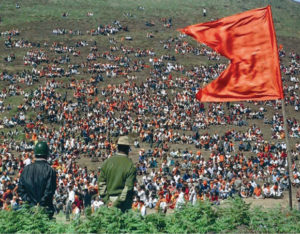
The Baba Budan Dargah, as it is popularly known, has been the site of a protracted battle in Karnataka for the last 10 years. Right-wing organisations like the Bajrang Dal, VHP and BJP have declared their intentions to “liberate” the Dargah and build a temple to the Hindu saint Dattatreya instead at the spot. At a public gathering in Chikmaglur in 2002, BJP MP Ananth Kumar famously declared that the party was committed to ensuring that “Bababudangiri would be the Ayodhya of the South.”
Historically, the Dargah has been revered by both sufi followers as well as Hindus. Legend has it that Baba Budan, a disciple of the famous sufi saint Dada Hayat Mirkalandar, chose the hill as a site for his monastery and lived there for years. Hindus regard the place as a resting spot of Dattatreya Swami. The caves, three hundred steps down, hold both the tombs of Baba Budan’s disciples and the footwear of Dattatreya Swami.
In June 2008, a portion of the cave collapsed and the district administration sealed the shrine. The repair work therefore is long overdue. Despite this, vociferous objections are being raised.
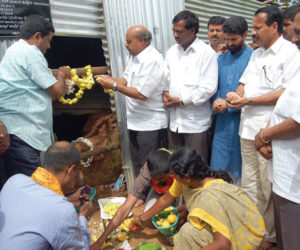 VHP and Bajrang Dal supporters at the Dattamala Abhiyana
VHP and Bajrang Dal supporters at the Dattamala AbhiyanaPhoto: KPN
Last December, hearing a case pertaining to the religious practices to be followed at the shrine, the Supreme Court had issued orders to maintain status quo at the shrine as on February 1989. Says 76-year-old Fairoz Khan, a staunch follower of Baba Budan, “The cave badly needs repair. But the government has started the project without sharing details with anyone. Has it forgotten the shrine is disputed? Forget seeking our consent, why wasn’t the Supreme Court apprised of the matter?”
Ashok KL, secretary of the Karnataka Communal Harmony Forum and one of the petitioners in the case, also maintains the ongoing work is a violation of the court order. “We believe this is a step towards changing the nature of religious practices followed at the shrine,” he says.
Documents obtained under the Right to Information Act (RTI) endorse what Ashok is saying. A project report submitted by the Torsteel Research Foundation contains a blueprint of the reconstructed shrine as envisaged by the consultants. In one instance, it recommends the construction of 52 pillars and a massive cover over the area where the tombs are located. For the sufi followers who throng the shrine, this is sacrosanct. Any change without consent is bound to attract objections. Says Khan, “If I go by the history of the government’s actions and their complete disregard for sufi practices, then I am bound to view this with suspicion. Why not take us into confidence?”
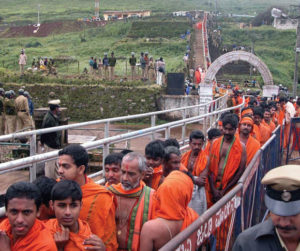 BJP state president DV Sadananda Gowda at the installation of Sri Dattatreya Swami idol at the dargah
BJP state president DV Sadananda Gowda at the installation of Sri Dattatreya Swami idol at the dargahIn a damning endorsement of this apprehension, BJP state president DV Sadananda Gowda told TEHELKA that the idol of Dattatreya Swami placed at the shrine during the inaugural puja would be part of the shrine after the restoration as well. Ask him if this counts as a violation of the Supreme Court stay order, since no idol was present at the shrine in 1989, and he says adamantly, “We will fight this within the courts and outside it.” Gowda, who participated in the inaugural puja, believes the September 8 ceremony was in accordance with Hindu religious customs and cannot be a violation of any legal authority.
THE CAVES HOLD THE TOMBS OF BABA BUDAN’S DISCIPLES AND THE FOOTWEAR OF DATTATREYA
The RTI documents, however, reflect other problems. The restoration project valued at Rs 2.09 crore has been awarded to a company that seems to have little expertise in repair and restoration of ancient structures. Waiving the tendering process mandated under the Karnataka Transparency Act, the contract was awarded to Binyas Contech Pvt Ltd, a Bellary-based company.
To prove that Binyas could meet the financial requirements, a letter signed by the Chikmaglur deputy commissioner lists the total value of projects handled by the company in the last six years. The figures reflect a sharp increase in the value of government projects bagged by the company, coinciding with the BJP government’s rise to power. P Shashidhar, general manager at Binyas, says, “What does our revenue have to do with the government?” – a statement belied by the fact that all the Binyas projects listed have been contracted out by the government.
RIGHT-WING GROUPS INTEND TO ‘LIBERATE’ THE DARGAH AND BUILD A TEMPLE INSTEAD
Binyas was upheld as a company with expertise in demolition and repair of old structures — a fact that the Binyas general manager himself does not assert. “We can’t say we are the only company with such expertise in Karnataka. There are other companies too,” he told TEHELKA. Asked to list out restoration of ancient structures the company has completed in the past, he mentions repair of a collapsed bridge in Hampi. The bridge was 10 years old and Hampi is a UNESCO World Heritage Site.
But the most disturbing fact is the manner in which the inaugural programme was done. As Ashok says, “The complicity of the government in furthering the agenda of the Bajrang Dal and VHP is worrying. When the Supreme Court’s orders were laid to waste, ministers, elected representatives, district officials and the superintendent of police were present. Where does that leave us?”
——————————
How the hill began to burn
- 1974: The shrine dear to Hindus and Muslims is transferred to the Wakf Board. In 1977, a district court rules that it is a syncretic shrine
- 1991: Karnataka High Court and Supreme Court uphold the syncretic nature of the shrine. It has a Muslim priest as well as Hindu practices
- 1998: Bajrang Dal and VHP declare they will “liberate” the shrine from Muslims on December 3. Rath yatras are organised across the state
- 1999: A Dattatreya Swami idol is installed. This violates a court order that only rituals practised prior to 1975 can be performed at the shrine
- 2002: BJP MP Ananth Kumar says ‘Bababudangiri would be made the Ayodhya of the South’. 10,000 people gather to protest this
- 2004: Government bans the Sangh Parivar’s ‘shobha yatra’. In 2005, it bans both the Datta Jayanthi puja and the 3-day sufi Urs
- 2008: Karnataka High Court says practices at the shrine should be reevaluated. In December, the Supreme Court orders status quo
———————
This article was originally published in Tehelka, a leading independent news magazine in India, known for its investigative journalism.
